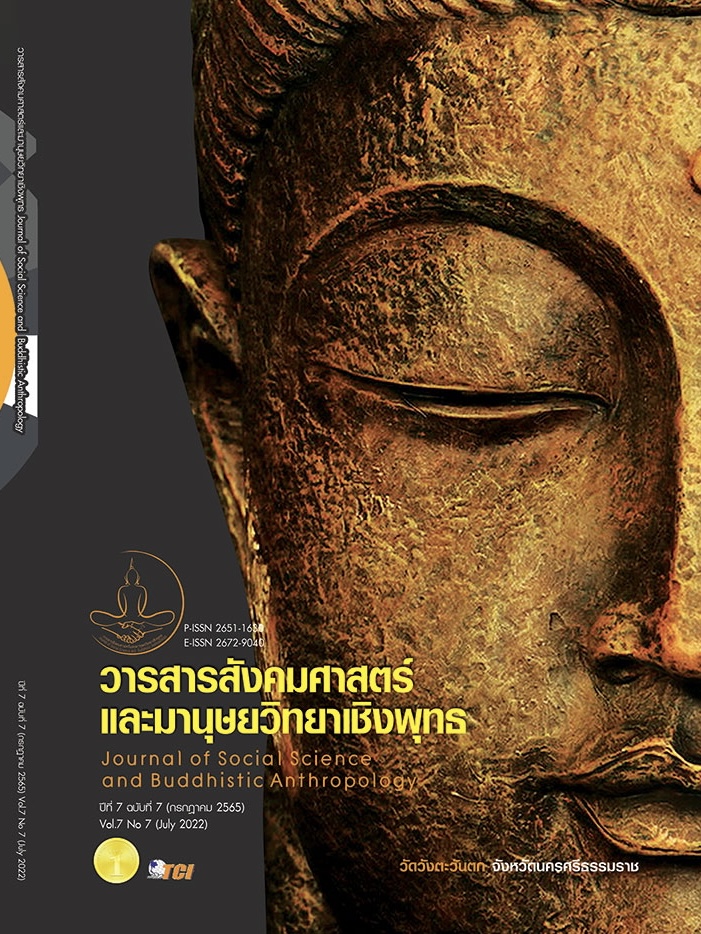MODEL AND MECHANISM TO PROMOTE GENDER EQUALITY IN ORDER TO SOCIAL EMPOWERMENT IN SCHOOLS OF SECONDARY EDUCATIONAL SERVICE AREA OFFICE 33, SURIN PROVINCE
Keywords:
Model and Mechanism, Gender Equality in Schools, Gender Equality Attitude, Social EmpowermentAbstract
The objectives of this research article were to 1) study the attitudes about gender equality among secondary school students in schools 2) compare the differences between factors and attitudes about gender equality. 3) study the operation on gender equality and problems of gender discrimination in schools. And 4) propose a model and mechanism for promoting gender equality in schools. An integrated study was conducted in schools under the Office of Secondary Education Service Area, District 33, Surin Province. This was the mixed research, a quantitative research with a sample group of 400 Mathayomsuksa 6 students. Using multistage random sampling, the tools were questionnaires, data were analyzed using statistics, percentage, mean, standard deviation, t-test and F-test. For the qualitative research, a sample was chosen by purposive sampling of 55 people. The tool was a semi-structured interview. The results showed that the issues that students had low attitudes were 1) women were more sensitive than men ( = 2.29) 2) daughters had to be more careful about sex than sons because sons were unable to get pregnant (
= 2.29) and 3) LGBTQ people are often assertive and funny (
= 2.35). Individual, family and school environment factors were significantly associated with attitudes towards gender equality (p < .05). As for the implementation, it was found that the school had arrangements for teaching and learning to promote gender equality. The problem condition found that there was verbal bullying about gender the most (91.25%). Finally, there should be a form of consulting, safe space, fair rules and teaching with gender equity using the engagement mechanism of students, teachers, school staff and Officers of Secondary Education Service Area.
References
ครู ก. (28 มกราคม 2563). สภาพการดำเนินงานเกี่ยวกับความเสมอภาคระหว่างเพศในโรงเรียนสังกัดสำนักงานเขตพื้นที่การศึกษามัธยมศึกษา เขต 33 จังหวัดสุรินทร์. (นางสาวลดาวัลย์ ปัญตะยัง, ผู้สัมภาษณ์)
นักเรียน ค 2. (23 มกราคม 2563). สภาพการดำเนินงานเกี่ยวกับความเสมอภาคระหว่างเพศในโรงเรียนสังกัดสำนักงานเขตพื้นที่การศึกษามัธยมศึกษา เขต 33 จังหวัดสุรินทร์. (นางสาวลดาวัลย์ ปัญตะยัง, ผู้สัมภาษณ์)
ปนิฏฐา จึงจะดี. (2549). ชีวิตกรรมกรหญิงที่ไร้สวัสดิการสังคม: ศึกษากรณีกระเป๋ารถเมล์หญิงมินิบัส. ใน วิทยานิพนธ์ศิลปศาสตรมหาบัณฑิต สาขาสตรีศึกษา. มหาวิทยาลัย ธรรมศาสตร์.
พิมพ์ชนก มีภา. (2559). ความเสมอภาคทางเพศในทัศนคตินักเรียนแพทย์เพศหญิง. ใน วิทยานิพนธ์ศิลปศาสตรมหาบัณฑิต สาขารัฐศาสตร์. มหาวิทยาลัยเกษตรศาสตร์.
เพ็ญประภา ภัทธานุกรม. (2558). การศึกษาเพื่อส่งเสริมความเท่าเทียม: ทางออกของความรุนแรงทางเพศ. วารสารร่มพฤกษ์ มหาวิทยาลัยเกริก, 33(1), 1-23.
มหาวิทยาลัยมหิดล, องค์การแพลนอินเตอร์เนชั่นแนลประเทศไทย และองค์การการศึกษาวิทยาศาสตร์และวัฒนธรรมแห่งสหประชาชาติ. (2557). การรังแกต่อกลุ่มนักเรียนที่เป็นหรือถูกมองว่าเป็นคนข้ามเพศ หรือคนรักเพศเดียวกัน ในโรงเรียนระดับมัธยมศึกษา. ใน รายงานการวิจัย. มหาวิทยาลัยมหิดล.
วิจิตร ว่องวารีทิพย์. (2559). ความหลากหลายทางเพศในแบบเรียนไทย. กรุงเทพมหานคร: มูลนิธิเพื่อสิทธิและความเป็นธรรมทางเพศ.
ศิริพร จิรวัฒน์กุล และคณะ. (2555). สถานการณ์การตั้งครรภ์วัยรุ่น: การรับรู้ของวัยรุ่นใน 7 จังหวัดของประเทศไทย. วารสารวิชาการสาธารณสุข, 21(5), 865-877.
สถาบันบัณฑิตพัฒนบริหารศาสตร์. (2562). สังคมไทยคิดอย่างไรกับเพศที่ 3. เรียกใช้เมื่อ 15 สิงหาคม 2562 จาก http://www.nidapoll.nida.ac.th/index.php?op=polls-detail&id=671
สมพร รุ่งเรืองกลกิจ และคณะ. (2557). การพัฒนาเครื่องมือประเมินทัศนคติต่อเพศภาวะ. วารสารพยาบาลศาสตร์และสุขภาพ, 37(4), 1-12.
สมพร รุ่งเรืองกลกิจ และคณะ. (2560). ทัศนคติของนักศึกษาในมหาวิทยาลัยแห่งหนึ่งต่อเพศภาวะในสังคมไทย. วารสารสังคมศาสตร์และมนุษยศาสตร์, 43(2), 84-114.
สำนักงานกิจการสตรีและสถาบันครอบครัว. (2554). ความเสมอภาค คือ ความสุข. เรียกใช้เมื่อ 12 พฤษภาคม 2562 จาก http://km.moi.go.th/km/18_gender/gender46.pdf
สำนักงานกิจการสตรีและสถาบันครอบครัว. (2557). การส่งเสริมความเสมอภาคหญิงชายในหน่วยงานภาครัฐของสำนักกิจการสตรีและสถาบันครอบครัว. เรียกใช้เมื่อ 12 พฤษภาคม 2562 จาก https://www.dcy.go.th/woman_man/data/278.pdf
อาทิตยา วรรณธาดา. (9 กรกฎาคม 2563). สภาพการดำเนินงานเกี่ยวกับความเสมอภาคระหว่างเพศในโรงเรียนสังกัดสำนักงานเขตพื้นที่การศึกษามัธยมศึกษา เขต 33 จังหวัดสุรินทร์. (นางสาวลดาวัลย์ ปัญตะยัง, ผู้สัมภาษณ์)
Ford, N. & Kittisuksathit, S. (1996). Youth sexuality: the sexual awareness, lifestyles and related - health service needs of young, single, factory workers in Thailand. Nakhon Pathom: Institute for Population and Social Research, Mahidol University.
Kosciw, J. G. et al. (2010). The 2009 National School Climate Survey: The Experiences of Lesbian, Gay, Bisexual, and Transgender Youth in Our Nation’s Schools. Washington DC: Gay Lesbian and Straight Education Network.
Robinson, J. P. & Espelage, D. L. (2011). Inequities in educational and psychological outcomes between LGBTQ and straight students in middle and high school. Educational Researcher, 40(7), 315-330.
Downloads
Published
How to Cite
Issue
Section
License
Copyright (c) 2022 Journal of Social Science and Buddhistic Anthropology

This work is licensed under a Creative Commons Attribution-NonCommercial-NoDerivatives 4.0 International License.








